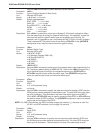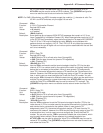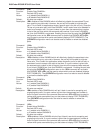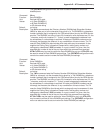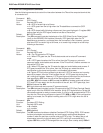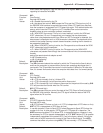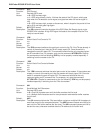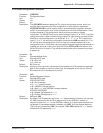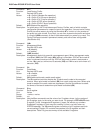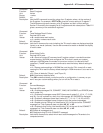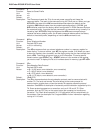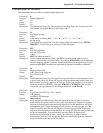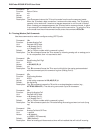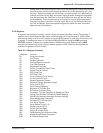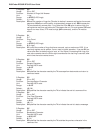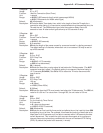
RASFinder RF300E/RF310E User Guide
RF300E/RF310E134
Command: &Fn
Function: Load Factory Profile
Unit: Decimal ASCII code
Values: n=0—Profile 0 (Modem-like operation),
n=2—Profile 2 (V.120 async operation),
n=3—Profile 3 (X.75 async operation),
n=4—Profile 4 (PPP async operation),
n=5—Profile 5 (HDLC async operation)
Default: &F0 (Modem-like operation)
Description: For quick setup, the TA includes several Factory Profiles, each of which contains
configuration parameters for a specific type of port operation. You can load a Factory
Profile into active memory by using the command &Fn, in which n is the number of
the profile you wish to load. If you wish, you can then customize the profile and store
it, using the &W0 command, so that it loads automatically on power-up or reset. The
Factory Profiles are stored in permanent memory and are not user-configurable.
(See Section 6.6)
Command: %Mn
Function: Management Mode
Unit: Decimal ASCII code
Values: n=0 (disable),
n=1 (enable)
Default: %M0 (disabled)
Description: Management mode is for use with a management agent. When management mode
is enabled (%M1) the DSR mode (&Sn) setting is overridden. DSR will be turned off
when in command mode and off-line. DSR will be turned on when in data mode or
on-line. !Hn is set to a minimum of 5 seconds (!H5) and *!Hn is set to a minimum of 5
seconds (*!H5).
Command: Qn
Function: Quiet Mode
Unit: Decimal ASCII code
Values: n=0—disable,
n=1—enable
Default: Q0 (disable quiet mode, enable result codes)
Description: The Qn command controls whether the TA sends result codes to the computer/
terminal. When quiet mode is disabled (Q0), then result codes are given. When quiet
mode is enabled, the result codes are suppressed. Use the Vn command to select
the format of the result codes when quiet mode is disabled (Q0).
Command: Sr=n
Function: Set S-register
Unit: Varies
Range: r varies; n varies
Default: n/a
Description: Use the Sr=n command to set the value of an S-register, where r is the number of
the S-register, and n is the value you want to set. For example, ATS7=60<CR> sets
S-register 7 to 60. Unsupported S-registers (r) report OK without any numbers.
Supported S-registers (r) that are given a setting (n) that is not valid return an
ERROR message. The L6 command gives a summary of all S-registers and their
current settings. Section D.2 contains the complete list of S-registers and their
descriptions. Table D.6 gives a summary of the available S-registers.



